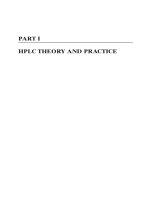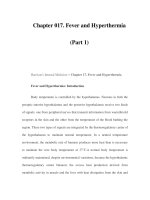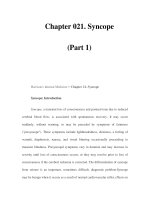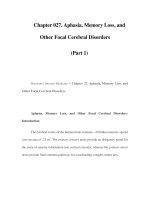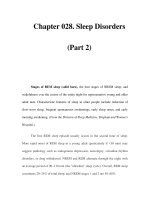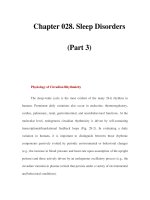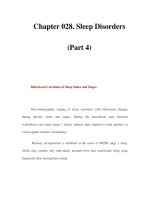Chapter 028. Sleep Disorders (Part 1) docx
Bạn đang xem bản rút gọn của tài liệu. Xem và tải ngay bản đầy đủ của tài liệu tại đây (28.18 KB, 5 trang )
Chapter 028. Sleep Disorders
(Part 1)
Harrison's Internal Medicine > Chapter 28. Sleep Disorders
Sleep Disorders: Introduction
Disturbed sleep is among the most frequent health complaints physicians
encounter. More than one-half of adults in the United States experience at least
intermittent sleep disturbances.
For most, it is an occasional night of poor sleep or daytime sleepiness.
However, the Institute of Medicine estimates that 50–70 million Americans suffer
from a chronic disorder of sleep and wakefulness, which can lead to serious
impairment of daytime functioning. In addition, such problems may contribute to
or exacerbate medical or psychiatric conditions.
Thirty years ago, many such complaints were treated with hypnotic
medications without further diagnostic evaluation. Since then, a distinct class of
sleep and arousal disorders has been identified.
Physiology of Sleep and Wakefulness
Most adults sleep 7–8 h per night, although the timing, duration, and
internal structure of sleep vary among healthy individuals and as a function of age.
At the extremes, infants and the elderly have frequent interruptions of sleep.
In the United States, adults of intermediate age tend to have one
consolidated sleep episode per day, although in some cultures sleep may be
divided into a mid-afternoon nap and a shortened night sleep.
Two principal systems govern the sleep-wake cycle: one actively generates
sleep and sleep-related processes and another times sleep within the 24-h day.
Either intrinsic abnormalities in these systems or extrinsic disturbances
(environmental, drug- or illness-related) can lead to sleep or circadian rhythm
disorders.
States and Stages of Sleep
States and stages of human sleep are defined on the basis of characteristic
patterns in the electroencephalogram (EEG), the electrooculogram (EOG—a
measure of eye-movement activity), and the surface electromyogram (EMG)
measured on the chin and neck. The continuous recording of this array of
electrophysiologic parameters to define sleep and wakefulness is termed
polysomnography.
Polysomnographic profiles define two states of sleep: (1) rapid-eye-
movement (REM) sleep, and (2) non-rapid-eye-movement (NREM) sleep. NREM
sleep is further subdivided into four stages, characterized by increasing arousal
threshold and slowing of the cortical EEG.
REM sleep is characterized by a low-amplitude, mixed-frequency EEG
similar to that of NREM stage 1 sleep. The EOG shows bursts of REM similar to
those seen during eyes-open wakefulness. Chin EMG activity is absent, reflecting
the brainstem-mediated muscle atonia that is characteristic of that state.
Organization of Human Sleep
Normal nocturnal sleep in adults displays a consistent organization from
night to night (Fig. 28-1). After sleep onset, sleep usually progresses through
NREM stages 1–4 within 45–60 min. Slow-wave sleep (NREM stages 3 and 4)
predominates in the first third of the night and comprises 15–25% of total
nocturnal sleep time in young adults.
The percentage of slow-wave sleep is influenced by several factors, most
notably age (see below). Prior sleep deprivation increases the rapidity of sleep
onset and both the intensity and amount of slow-wave sleep.
Figure 28-1

